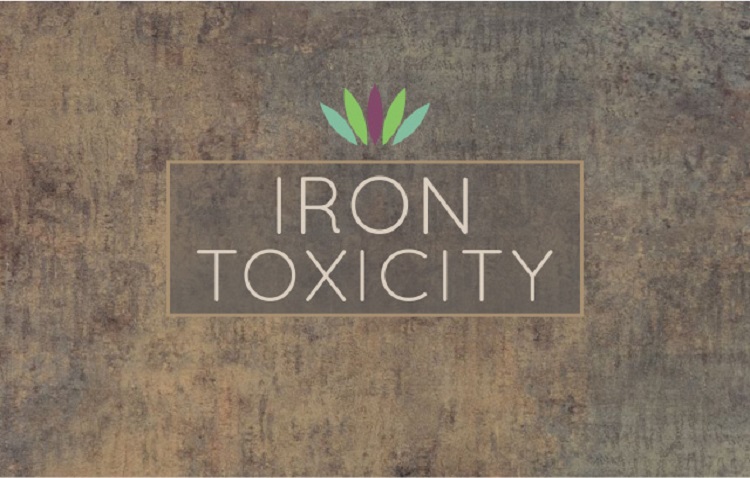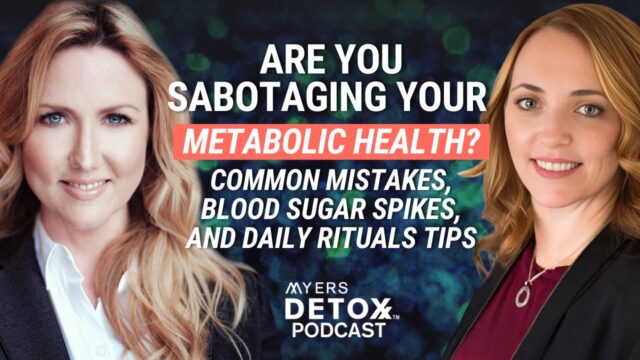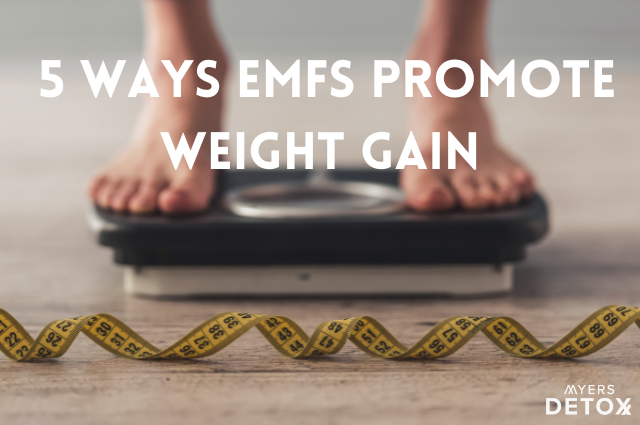We all know that iron is an essential mineral for growth, development, and long-term survival. However, iron toxicity is the stealth threat facing every man and postmenopausal woman. It can lead to an array of life-threatening conditions like diabetes, heart disease, cognitive decline, thyroid trouble, liver failure and cancer. Learn how to detox it by reading more below!
The Danger of Iron Accumulation
It absolutely astounds me that more doctors aren’t giving iron overload the attention it deserves, including many holistic practitioners. You could even be doing everything right for your health and be at high risk for this health-wrecking threat known as iron toxicity.
Iron toxicity is extremely dangerous, not only because of the long list of harmful effects it can have on your health – including death – but also because it is so commonly overlooked. And it targets every single man and postmenopausal woman.
The alarming, and even deadly, effects that toxic iron levels have on human health can be broken down into three primary categories. From these, all conditions subsequently stem (5):
- Deposits in body organs and tissues including the heart, brain, liver, pancreas, and joints
- Displaces vital nutrients
- Causes psychological effects
Iron builds up in the body quite easily because it is so important for survival. It transports oxygen to the body’s tissues via hemoglobin. So, when exposed to iron, most commonly in enriched flour and water, the body preferentially retains it and stores it in the body.
Excess iron can lead to one of the most dangerous reactions in your body — the Fenton reaction — that decimates your mitochondrial DNA, proteins, and membranes and contributes to system-wide inflammation and oxidative stress.
When this happens, all you may initially notice is some joint pain, fatigue, gut pain, memory fog, or an irregular heartbeat.
Even moderately elevated levels of iron can contribute to:
- Obesity — Obese individuals are more likely to have high levels of iron in their bodies.
- Cancer — Elevated levels of iron are found in patients with many types of cancer, including breast cancer, melanoma, pancreatic cancer, renal cell carcinoma, and Hodgkin’s lymphoma.
- Alzheimer’s, Parkinson’s and ALS — High levels of iron in your brain tissue (which can easily happen as you age) can lead to cognitive impairment and inflammation.
- Cardiovascular disease — Women’s risk of heart disease rises significantly after they either go through menopause or have a hysterectomy (and stop losing blood each month through menses).
- Diabetes — Men with high iron stores were found to be 2.4 times as likely to develop Type 2 diabetes as men with lower levels.
- The growth of pathogens — High iron levels facilitate the growth of disease-causing bacteria, fungi, and protozoa.
- Osteoporosis — Too much iron in your body can damage your bones, but unfortunately, symptoms don’t typically appear until your levels are dangerously high.
In today’s modern medicine, iron toxicity is often overlooked when treating ailments such as fatigue or anemia with iron supplementation. And while it’s crucial to maintain healthy levels of this essential element so your body can run at its optimal level, it’s just as important to keep those levels in check and detox before an iron overload does serious harm. those in the developing world are especially susceptible to iron toxicity.
This is why I believe iron, perhaps more than any other metal, needs mineral balancing!
A note on anemia: most cases of “anemia” – low blood iron levels – are actually caused by copper toxicity!
Types of Iron
- Heme – Heme iron is attached to a heme molecule. It is found only in animal protein – meats, poultry, and fish – especially red meat (1). It is so readily absorbed that it’s considered the best source of iron for those suffering from iron deficiency. In fact, heme iron is absorbed at a “relatively constant rate of about 23%” (2). But, according to the Iron Disorders institute, “too much heme iron in the diet can increase the risk of disease for some people with abnormal iron metabolism such as hemochromatosis.” (1, 3)
- Non-heme – Non-heme iron is found in mainly in plants and vegetables but also in nuts, fruits, tofu, most iron pills, and fortified foods. The largest quantities of non-heme iron can be found in grains such as rice, wheat, and oats (3). It is not as readily utilized by our bodies and has a lower absorption rate than heme iron, ranging from 2-20% (2).
How You Are Exposed to Iron
Our greatest exposure of iron is from enriched flours. This is a form of iron that is literally flakes of iron and not usable by our body. This is a marketing ploy used by food manufacturers to make you think they are ‘enriching’ flour for your health. Ironically, the carbs in these refined grains not only contribute to diabetes, but the iron build up in the liver is just as responsible for this growing epidemic.
Our next greatest exposure to iron is, arguably, from our drinking water. Iron seeps its way into our water from naturally occurring geological sources. It also gets in through the corrosion of both our distribution systems and household plumbing. The pipes used in the aforementioned systems are widely made up of iron-based materials, including galvanized steel and cast iron (4).
Think of all the iron your water is passing through before it even reaches your tap! If you have red stains around your drains, you have iron in your body.
Learn how you are exposed to iron by taking a look at the following sources (5, 6, 7, 8):
- Drinking water (1, 5)
- Iron Enriched flour (6, 9)
- Occupational exposure (welders, metal workers, miners, machinists, plumbers, mechanics, steel workers) (9)
- Contaminated soil
- Multivitamins (adult, pediatric, prenatal)
- Iron supplements (to treat anemia)
- Meats (2, 5)
- Poultry (2)
- Fish and Shellfish (2, 5)
- Liver and other organ meats (5)
- Legumes (2, 5)
- Beer (1, 5)
- Beets (5)
- Black cherries (5)
- Bone meal
- Bran
- Chives
- Canned tomatoes
- Egg Yolks – Iron from egg yolks is not well-absorbed, unless paired with a source of vitamin C, like a glass of orange juice (5)
- Galvanized iron containers
- Molasses (5)
- Nuts (5)
- Red wine (1, 5)
- Dried fruits (5)
- Seeds (5)
- Soy/Tofu
- Tobacco (9)
- Canned Tomatoes
- Yeast (5)
- Wheat germ (5)
- Whole-grain cereals (5)
- Whole-grain breads (5)
- Herbs (particularly peppermint leaves, comfrey root, black chohosh root, chickweed, and goldenseal root) (5)
- Iron pipes (1)
- Iron cookware (1)
Iron from the source in my next list is non-heme iron. Remember, it can also be absorbed, but less so. This is because of the presence substances that interfere with iron absorption, such as of phytates, oxalates, tannins (5):
- Kale (5)
- Collard Greens (5)
- Mustard Greens (5)
- Spinach (5)
- Swiss Chard (5)
- Tomato juice (2)
- Green beans (2)
- Artichokes (2)
- Dried Fruits (2)
- Corn flour (2)
So we’ve just taken a look at some of the sources from which your body may be acquiring iron. But it’s also important to note the role acid (and, in turn, all acidic foods and drinks) and our cookware play in the absorption process.
Acid enhances the absorption of iron into the body. For instance, think of when you drink a glass of orange or coffee juice with your breakfast. Similarly, when alcohol in any amount is consumed with food – like having a glass of red wine or a cold beer with dinner – iron absorption is further facilitated (1, 10).
Now let’s consider your cookware: the acidic nature of some foods like tomato products make them likely to leach iron from your iron pots, pans, and skillets (5). In fact, cooking with such materials can increase the iron content of foods prepared in them by as much as 3 to 400 percent (1). I highly recommend AGAINST using cast iron cookware for this reason. The iron in cast iron pots is not in the ferrous form our body can readily utilize. It is ferric iron that our bodies cannot use, which just builds up in your body contributing to potential iron toxicity.
Besides what is listed above, dangerous iron toxicity can also happen quite quickly when patients overcompensate their iron intake with iron pills. These are often taken and/or prescribed to help treat issues associated with a lack of iron, including anemia and fatigue (5). Some people have even been known to die from an overdose of iron (11)! And while low iron is certainly worthy of consideration and close monitoring, it’s important to know that iron toxicity in and of itself can be deadly.
See why it’s so important to keep all of your minerals properly balanced?
Symptoms of Iron Toxicity
Iron toxicity occurs when high levels of the element are accumulated in the body, leading to hemochromatosis. Excess iron can deplete vitamin B6 and vitamin C, as well as cause a deficiency of manganese, zinc, and copper. Many of the adverse physical health conditions caused by iron toxicity are a direct result of these deficiencies (5).
Hemochromatosis is an iron storage disease that occurs when there is an overload of iron in the body. It is the consequence of the intestine’s inability to keep out unneeded iron (10). Iron accumulates in the organs, often iron-storing organs like the liver, and damages the tissues.
There are two primary types of this iron toxicity disease:
- Inherited / congenital (present since birth) Primary Hemochromatosis. This type of iron overload can be attributed to a gene that enhances the body’s iron absorption (2, 5).
- Acquired or Secondary Hemochromatosis. This type of toxicity develops as a result of iron your body acquires through both toxic exposure and the long-term overconsumption of this metallic element.
The threat of iron toxicity is a big issue, not only because of the long list of adverse health conditions it can cause, but also because it so often goes undiagnosed. Doctors are looking for blood levels or iron and not the iron levels in the body’s tissues. Iron toxicity symptoms are regularly attributed to other conditions, or worse, simply overlooked during an effort to treat low blood iron or fatigue with iron supplements (5).
The major concern when it comes to iron toxicity is that it can induce mild copper deficiency and produce cardiac disease in humans of all ages. What happens is that iron overload increases the dietary copper requirement of the animals and can lead to copper deficiency. This is why people with iron overload may benefit from copper supplementation, particularly if they habitually consume a diet low in copper. (14)
Iron is corrosive to the lining of the gastrointestinal tract, which is why the first sign of iron poisoning through ingestion is stomach pain (13). This may also be accompanied by nausea and/or vomiting.
If you are afraid you are suffering from iron overload, please take a look at the list of iron toxicity symptoms below and note of any you may be experiencing (1, 2, 5, 9, 10, 12, 13, 14, 15, 16, 17):
- Aches and pains
- Aggression
- Allergies/ histamine (1)
- Amenorrhea – cessation of menses (2, 10)
- Anemia
- Anger/Bad temper (5, 9)
- Anorexia (10)
- Arthritis, rheumatoid (5, 10)
- Bacterial infections (chronic) (1, 5)
- Birth defects (5)
- Bleeding gums (5)
- Cancer (5, 9)
- Cardiomyopathies (5)
- Chills
- Cirrhosis of the liver (1, 5, 10, 15)
- Coma (decreased level of consciousness and lack of responsiveness, may occur within 1/2 hour to 1 hour after overdose)
- Constipation (5)
- Convulsions
- Copper deficiency (14)
- Damage to blood vessels
- Death (17)
- Darkened Skin pigmentation (2)
- Dehydration
- Diabetes (1, 5, 9, 15)
- Diarrhea (10)
- Diphasic shock (10)
- Dizziness (5)
- Drowsiness
- Emotional problems
- Enlarged Liver (2)
- Fast and weak pulse
- Fatigue (2, 5)
- Fever
- Flushing
- Gray-ish hued skin discoloration (5)
- Headaches (2, 5)
- Heart disease and heart failure (5)
- Hemochromatosis (5, 10)
- Hepatitis (1, 5)
- Hepatic fibrosis (15)
- High Blood Pressure
- Hostility (5)
- Hyperactivity (1, 5)
- Hypertension (1, 5, 9)
- Hypothermia (10)
- Impotence (10)
- Infections (5)
- Insomnia (5)
- Impotence
- Inflammation
- Irritability (5)
- Joint diseases (2)
- Kidney problems
- Lethargy (2)
- Liver disease and/or damage
- Loss of body hair (2)
- Loss of weight
- Low blood pressure
- Lowered work performance (2)
- Mental problems (5)
- Metabolic acidosis
- Metallic taste in mouth (5)
- Migraines (1)
- Muscle atrophy (16)
- Myasthenia graves (5)
- Nausea (5, 13)
- Nervous system disorders
- Nervousness (5)
- Oliguria (10)
- Pallor (loss of color form the skin)
- Pancreas damage
- Parkinson’s disease (1, 5, 9)
- Premature aging (5)
- Pulmonary alveolar proteinosis (16)
- Renal failure
- Rosacea (16)
- Schizophrenia (5)
- Scurvy (5)
- Shock
- Shortness of breath
- Sickle-cell anemia (5)
- Stomach pain (13)
- Strabismus (rapid eye movement)(5)
- Sudden onset of shortness of breath
- Thyroid disorder
- Vascular congestion of the gastrointestinal tract, liver, kidneys, heart, brain, spleen, adrenals, and thymus (10)
- Viral replication (16)
- Vomiting (13)
In addition to those mentioned above, iron toxicity may also alter a person’s brain chemistry and affect one’s mood or personality! (12) An overload of this metal is often associated with a strong ego, rigidity, tenaciousness, hostility, stubbornness, and irritability. (5)
Iron also raises Na (Sodium) levels. Slow oxidizers have low sodium levels; so if you are a slow oxidizer, please take this into consideration as well.
Those most susceptible to iron toxicity are men, children, and people who find themselves exposed to high levels of iron through their occupations (5). Women may still find themselves experiencing iron overload, though their risk is lower. This is because a monthly menstruation actually helps to eliminate extra iron from the body and help regulate it (12).
Remember, it’s important to confirm that an excess of iron is to blame before you begin treatment to correct a possible mineral imbalance. Especially since, in the case of iron, deficiencies and overloads can lead to serious health consequences.
Toxic levels of elements, like iron, replace nutrient minerals in enzyme binding sites. When this occurs, the metals inhibit, over-stimulate, or otherwise alter thousands of enzymes. An affected enzyme may operate at 5% of normal activity. This may contribute to many health conditions. Toxic metals may also replace other substances in other tissue structures. The replacement weakens these tissues, such as the arteries, joints, bones, and muscles. Toxic metals may also simply deposit in many sites, causing local irritation and other toxic effects.
This is why if your body is not getting enough zinc, copper, B6, manganese, and the other nutrients it needs, it will simply absorb more and more iron to supplement what’s missing. See why mineral balancing is so important?!
Antagonists of Iron
When iron reaches toxic levels, it replaces vital minerals in the body, causing enzyme dysfunction. Toxic metals may also replace other substances in other tissue structures. The replacement weakens these tissues, such as the arteries, joints, bones, and muscles.
An antagonist is an element that can boost your body’s ability push or detox a contaminant out of the body. The following elements can work as antagonists of iron and help facilitate the body’s natural excretion of the it from your system (1, 5, 9, 14, 18, 19):
- B6
- Manganese
- Cadmium
- Calcium
- Copper
- Cobalt
- Chromium
- Magnesium
- Manganese
- Zinc
- Nickel
- Vitamin E
- Vitamin B12
- Vitamin D
- Phosphates
- Antioxidant rich foods
- Egg proteins
- Long-chain fatty acids and phytates found in cereals
You’ll see that I have copper listed above as one of the antagonists to iron. This is because a study conducted by the United States Department of Agriculture, Agricultural Research Service, found that “people with iron overload may benefit from copper supplementation, particularly if they habitually consume a diet low in copper” (14).
This does not mean to go out and start taking copper. You need to have hair, urine and blood levels checked to see if you need copper. You can become toxic in copper as well like any metal!
A final note about absorption: vitamin C enhances iron absorption, as does a deficiency in vitamin B6! (5)
Again, it all comes back to balance.
A body that is well balanced will be one that is well protected from iron toxicity. As such, a balanced diet rich in minerals is crucial to maintaining optimal health, as well as reduce the amount of iron that becomes concentrated in the body.
Detecting Iron Toxicity
Everyone has iron in his or her body. But it’s not always at safe levels.
When investigating possible iron toxicity, we first perform a Hair Tissue Mineral Analysis (HTMA). HTMA testing measures heavy metal and mineral concentrations in your hair, which is one of the most common places that heavy metals like to hide. It’s a good way to get a highly accurate snapshot of what’s going on in your body without invasive procedures or expensive scans.
The HTMA testing process is simple (you don’t even need to leave your house). You get a digital kit sent to your email, then you send in your hair sample, and get your results within a few weeks. Testing is both accurate and comprehensive –– an HTMA test will give you information about a wide variety of heavy metals, including iron.
Once you have your HTMA test results, you can look at them with a trained practitioner and come up with a personalized plan to support your body’s natural detoxification.
When it comes to iron, the important thing to look for here is not just iron at its face value on your test, but also its relation to other minerals in the body.
A few things to note when testing for iron:
- To reiterate: everyone has iron in their body. It is is an essential mineral for growth, development, and long-term survival. But some peopel are suffering form iron overload.
- Your first hair test may not reveal an iron problem. This is because iron is stored deep in the tissues of the body, including the liver, and may need up to year before that iron is moved and starts to reveal itself on a hair test (5).
- It’s not always black and white: high iron on a hair mineral analysis may actually represent a loss of iron due to protein catabolism and a release of iron from cells.
- A blood test is also a great way to measure your iron levels. One of the things tested for in blood work is plasma ferritin. One of the jobs of ferritin is that it stores iron in a non-toxic form, ready to be transported and deposited in a safe form when it is required. Plasma ferritin is also an indirect marker of the total amount of iron stored in the body, explaining why serum ferritin is used as a diagnostic test for anemia (aka, iron deficiency) (13, 20).
If you think you’re dealing with iron toxicity and looking for a place to start, order a Hair Tissue Mineral Analysis. From there, you can plan your next steps to reclaim your vitality.
Takeaway
If you are concerned about iron overload, an HTMA is a great place to start. It can give you the information you need to address the root causes of physical and emotional health issues. If you suspect you have a build-up of toxins or a micronutrient imbalance, or you have unexplained symptoms like brain fog, weight gain, fatigue, or hair loss, you will certainly benefit from getting an HTMA.
After a long search and after having worked with multiple labs, I send all of our hair samples to an internationally-recognized lab that is a world leader in HTMA laboratory services. They’ve run more than 100,000 tests, and they process hair samples without washing them, which sets them apart from many other labs (washing a sample removes minerals, which leads to inaccurate results for proper interpretation).
If you think you may have toxin build-up or a mineral imbalance and you want definitive, accurate data on your health, you can order your HTMA here.
*These statements have not been reviewed by the FDA. A Hair Mineral Analysis (HTMA) is not intended to diagnose, treat, cure, reverse, or prevent any disease. It is not intended to replace any other medical test(s) that may be prescribed by your medical doctor.










